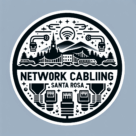What Is a LAN Cable? A Complete Guide to Networking at Home and Work
If you’re setting up a home network or an office system, understanding what a LAN cable is is essential. A LAN cable connects your devices to a local area network (LAN), enabling fast and reliable communication between computers, printers, servers, and the internet. While Wi-Fi is convenient, a wired connection using a LAN cable is often more stable, faster, and secure. Our expert structured cabling technicians in Santa Rosa ensure reliable network connections for both homes and businesses.
What Is a LAN Cable and How Does It Work
A LAN cable, also called an Ethernet cable, is a physical cable used to connect devices to a network. It carries data signals between your computer, router, switch, or modem, allowing devices to communicate and access the internet.
Most LAN cables use twisted pairs of copper wires to reduce interference, ensuring that data travels quickly and accurately. Popular types include:
- Cat5e – Supports up to 1 Gbps speeds, suitable for basic home networks.
- Cat6 – Supports up to 10 Gbps over shorter distances, ideal for offices and high-bandwidth applications.
- Cat6a and Cat7 – Designed for advanced setups, offering higher speeds and better interference protection.
Using a LAN cable ensures that your network connection is consistent, which is particularly important for activities like streaming, online gaming, and video conferencing.
Benefits of Using a LAN Cable
While Wi-Fi offers convenience, LAN cables provide several advantages that make them indispensable for many setups:
- Faster speeds – Wired connections typically outperform wireless networks in data transfer rates.
- Reliable connections – Less interference and downtime compared to Wi-Fi.
- Security – Harder for hackers to access a wired network.
- Low latency – Essential for online gaming and video streaming.
- Supports multiple devices – Can connect multiple computers, printers, and servers efficiently.
Common Uses for LAN Cables
LAN cables are widely used in both residential and commercial environments:
- Home networks – Connect computers, smart TVs, gaming consoles, and printers.
- Business offices – Link workstations, VoIP phones, and servers to a centralized network.
- Data centers – Backbone connections for switches, routers, and servers.
- Industrial systems – Connect machinery and security cameras for reliable data transfer.
No matter the setting, using a LAN cable ensures your devices communicate efficiently and reliably.
How to Choose the Right LAN Cable
Selecting the correct LAN cable depends on your network requirements:
- Speed needs – Cat5e is fine for basic networks; Cat6 or Cat6a is better for high-speed applications.
- Distance – Longer runs may require higher-grade cables to maintain performance.
- Environment – Plenum-rated cables are recommended for spaces with air ducts or strict fire codes.
- Future-proofing – Choose cables that can handle higher speeds to avoid upgrading too soon.
Professional installers can help assess your environment and recommend the best type of LAN cable for your network setup. When setting up LAN cables, it’s important to follow the correct wiring sequence. Learn more about using different RJ45 color codes and how they affect your network performance.
LAN Cable vs. Wi-Fi: Which Should You Use?
While Wi-Fi is convenient, a LAN cable provides a stable and faster connection. Many modern setups combine both, using Wi-Fi for mobile devices and LAN cables for desktops, servers, and critical systems. This hybrid approach ensures both mobility and performance.
Upgrade Your Network with the Right LAN Cable
If your internet feels slow or your connection drops frequently, a wired LAN setup may solve your problems. Properly installed LAN cables improve speed, reliability, and overall network performance for homes and businesses alike. For homes with coaxial wiring, a MoCA adapter can enhance network speed and stability without requiring new Ethernet lines.
Contact a professional installer to design a wired network using high-quality LAN cables, and experience a faster, more dependable connection across all your devices.
